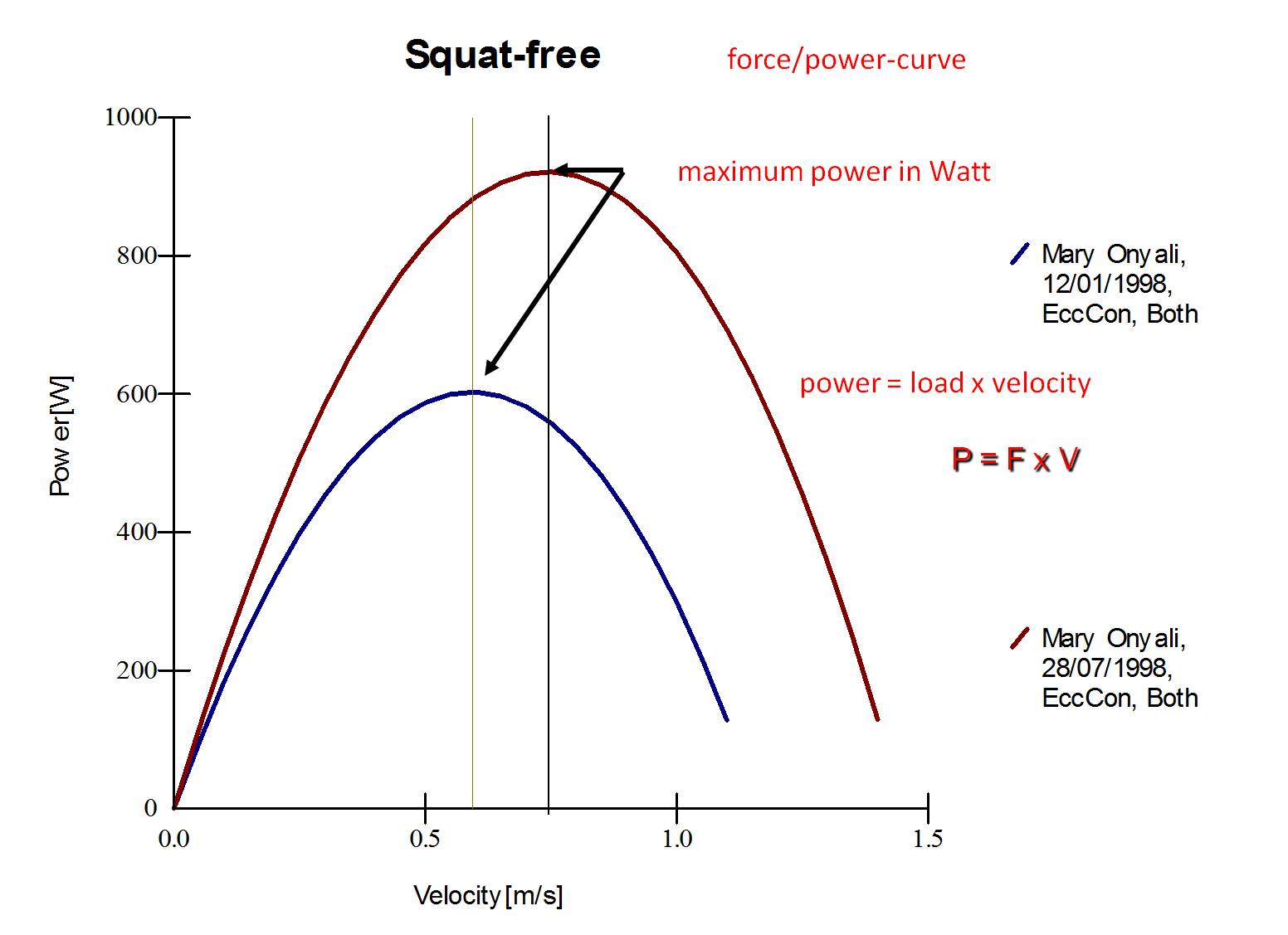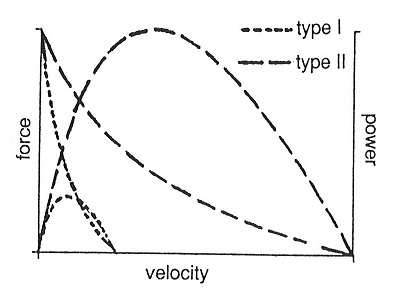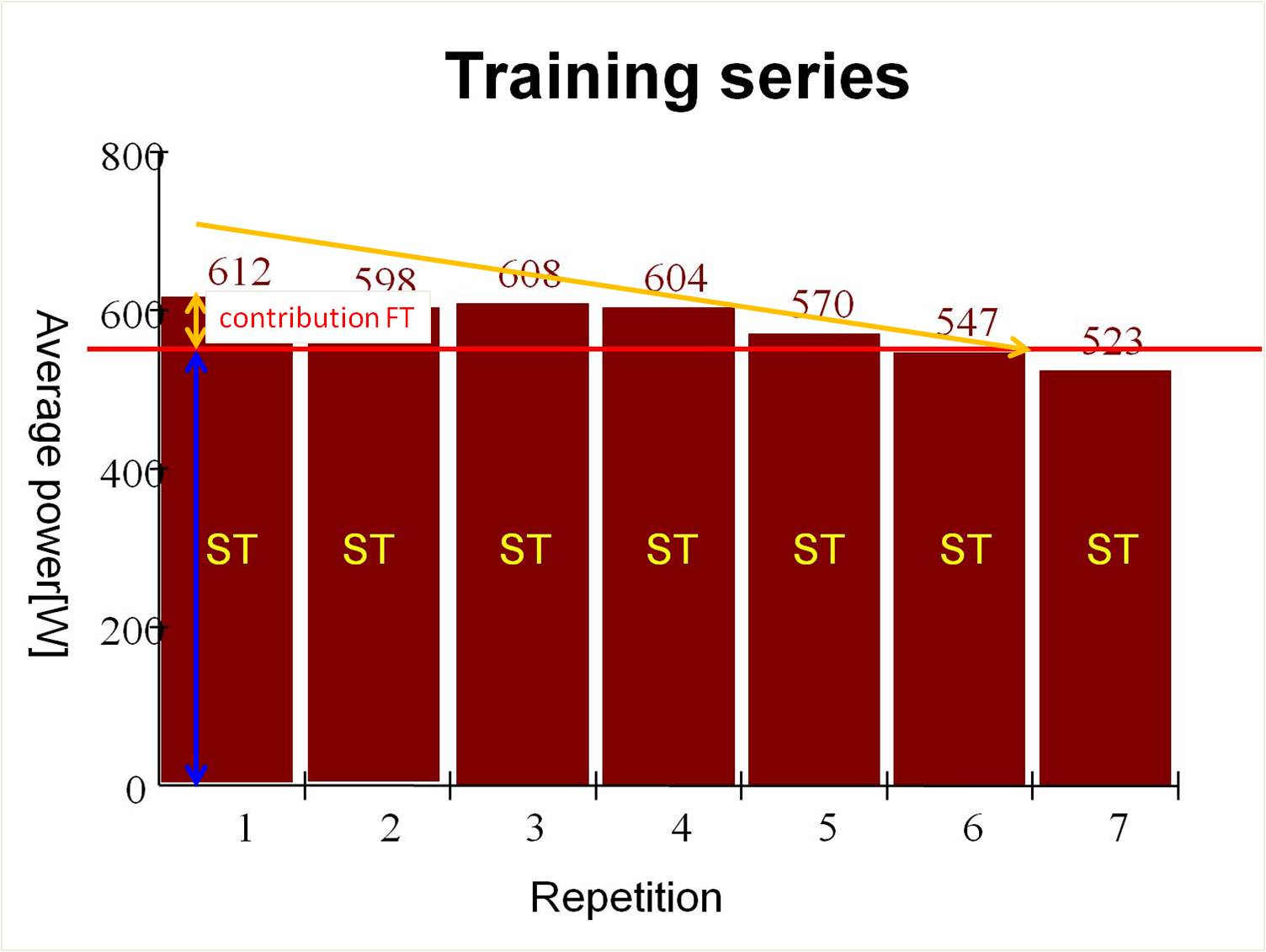Yes, maybe I have been boring you with too much non-technical information about training and coaching.
Of course, most coaches want to know the secret recipe, the golden exercise, the magic tool, that changes his/her athlete into a medalist overnight, at the same time knowing such things do not exist.
But maybe you’re right, let’s devote some time on new concepts and older concepts explained or reintroduced.
Let’s start with two very important practical, but underused and misunderstood principles: the force/velocity-curve and the force/power- curve which are extremely important for improving explosive strength and power.
Power (P) is the product of a given force (F in N) (read load) and the velocity (v in m/sec) with which that load is moved. In many cases the load is more or less constant. Like a ball, a shot, a javelin, an implement like a tennis racket or baseball bat, but most important, our own bodyweight., in case of running and jumping. P = F x v and power is expressed in Watts or Nm/sec.
The higher the velocity with which you move this load, the higher the power you generate.
So two relatively easy parameters:
1. the load which you know
2. the velocity you can measure.
It’s not that simple since the force (F) is not constant, but changes according to the acceleration (a) of the mass or load (m). Stand on a scale in an elevator and you will see yourself (mass) getting heavier or lighter depending on the direction and the acceleration of the elevator. F = m times (g+a) g = is the constant of gravity or 9.81m/s2. This is important when measuring power with equipment since some equipment uses the wrong formula here! (F= m times g).
Anyhow, the higher the velocity with which you move an implement or yourself, the more important power becomes. Looking for a maximal velocity we have to look at generating maximal power too.
Now one of the few sports in which power barely plays a role is …. powerlifting! In powerlifting velocity doesn’t really matter. It doesn’t matter if you get the bar up in 1 second, 10 seconds, or 1 minute as long as you get it up. In weightlifting it is completely different. Take a barbell over 60% of your 1 RM and try to lift overhead it in slow motion …..impossible. So in weightlifting power is a dominant factor!
Or try to throw a ball or javelin very far with a low velocity, try to jump far or high in slow motion or with a low knee extension velocity. The faster you execute the proper movement, the further your throw and the higher your jump.
So for me it was easy to see that power is an important target in strength training for many if not all sports. Still many coaches and athletes are looking at the numbers on the barbells and want to see these as high as possible, trying to increase the 1RM all the time, looking for increase in maximal strength. But you move your 1RM slower than your 10 RM and again this is slower than the actual movement in the field.
Power is more important than strength in many sports.
Therefore increasing power becomes more important than increasing maximum strength.
So how do we measure power. First of all we have to establish the force/velocity-curve from which power is derived.
The force/velocity-curve is easy to understand: the heavier the load you are moving, the slower the movement will be executed. Dependent on the movement single joint (knee extension) or multi-joint (leg press) and slightly curved or a straight line will show us this relationship.
Unfortunately we still need a piece of equipment to measure the velocity of the bar, manual timing won’t work. Coming from Europe, I use the MuscleLab or the Smartcoach. The velocity encoder (a little box stands on the floor with a thin cable attached to the bar, this box measures the velocity accurately and sends this to the software in the laptop, which produces the graphs and all the other data.
In real life: choose an exercise, let’s say free squat. Now a estimate the 1RM of the athlete and most of the time they already know. Let’s assume it is 180 kg.
To get a proper curve, I have to measure more different weights and disperse these weights evenly over the range, I mostly use 3-4 different weights, using 5 or more doesn’t make a difference in accuracy anymore. So with a 1RM of 180 kg, I use 30, 60, 90 and 120 kg, but I also could have used 40, 80, 120 and 160 kg.
Now the athlete has to make 5 reps with 30 kg with maximum velocity, but keeping the heels on the floor, since a jump squat is different from a squat.
The software calculates and stores the rep with the highest power output.
We repeat the same with 60 kgs, of course the velocity is slower than with 30 kgs, taking the highest power output again.
The same procedure with 90 kgs and 120 kgs. (at the first test – blue line, we left the 120 kgs out because of the risk of lifting heavy weighst after coming back from giving birth)
In the higher range I am not forced to make 5 reps, but 2, 3 or 4 will do, dependent on my judgment of proper execution. The system also has a build-in warning if the amplitude is too low, since with higher load the athlete tends to go not as deep as with the lower loads.
You have to make sure that every rep of every load is executed at maximum velocity. Quality is king! (as always).
Now I have the force/velocity-curve. (blue line in the graph = first test, brown line = last test). And I can extrapolate to MVIC, maximum voluntary isometric contraction (around 2000 N), note: that is not the 1RM!
Each point of the blue line (load) related to the velocity related to a load, related to it.
Now I know the force (load) and the related velocity it is easy (for the software at least) to calculate the force/ power-curve.(blue line = first test, brown line = last test)
 The force/power-curve shows as an inverted U-curve with a maximum. The top of this curve is not a sharp peak, but rather flat which means there is some range in which the power is close to maximum, normally 30-70% of the 1RM. In this case it was 90 kg, the weight with which we trained. See the two curves combined unter here.
The force/power-curve shows as an inverted U-curve with a maximum. The top of this curve is not a sharp peak, but rather flat which means there is some range in which the power is close to maximum, normally 30-70% of the 1RM. In this case it was 90 kg, the weight with which we trained. See the two curves combined unter here.
Here is the core principle: to increase power you have to move any load at maximum velocity, it doesn’t matter if it is 30% of 60% of your 1RM.
But why training power this way: simply because the involvement of muscle fibers does not only depend on the load as most of us think, but mainly on the velocity. Training power this way gives us a way to train the relevant muscle fibers!
If you train strength, you increase strength and to a certain extent you increase power, you’re lucky if you’re able to increase speed. The force/velocity-curve mainly shifts upward and only at the left side of the graph.
If you train power, you increase power, you increase strength and you increase speed, which means the whole force/velocity-curve shifts up and to the right.
The force/velocity- and the force/power-curve are perfect tools to monitor your strength qualities over time. Working without is having a dashboard in your car which only displays the total mileage driven, not the speed nor the RPM. You can see the shift from the blue lines to the brown lines in 6 months training. Red arrow 1: increase in strength, red arrow 2: increase in power and red arrow 3: increase in velocity
Guess which muscle fiber bgenerates the highest power output? It is the fast twitch or type II fiber. (for the advanced: especially the type IIB or IIX fiber).
 So if you want to improve the qualities of that fiber type you have to generate power and lots of it too.
So if you want to improve the qualities of that fiber type you have to generate power and lots of it too.
And here may be another eye-opener. We always assumed that the biological response of the first rep within a set (e.g. of 10 reps) will be the same like the last rep in that set. But if you looked well, something changed, not the load, but the velocity of the bar. And always in the same direction, it slowed down. Ever wondered why this is?
It is the powerful fast twitch fiber which drops out of the recruitment pattern. Due to its tremendous energy consumption, fast fibers are fast fatigued too, a price to pay for the high power output.
After a few reps you solely used slow twitch fibers (type I) and increase those in size.
In this graph you see the decrease in power output within a single set of squats with 90 kgs.
The athlete generate a maximum of approx. 600 W with 90 kgs. (see the top of the blue lines in the graphs above), so she had to at least generate 600 times 90% = 540 Watts. 90% threshold = yellow line. You can easily see the decrease in velocity, despite the effort to produce maximum velocity in each rep. Fast fibers drop out after 6 reps, from that moment on she only recruits slow twitch fibres.
This methods allows us to:
1. determine the optimal intensity for power training
2. determine the optimal repetitions in each set
A lot of people have something to say about the use of fiber types within movements, but the only way to really figure it out is to use muscle biopsies (long-term) or EMG (real-time) and I know very few people who do this. As one of my mentors used to say: in God we trust, all others show data!
So here is the most important and practical issue.
If you want to improve explosive strength or power, you have to recruit the fast twitch muscle. If you only use the slow twitch muscle, but move too slow and/or make too many reps, you will get slower in the end due to selective hypertrophy of slow twitch muscle.
For humans it is impossible to selectively recruit fast twitch muscle (but cats can: see them step into a puddle or stick some adhesive tape on their rear paw). No matter how fast you move slow twitch muscle will always be involved. So the trick is to anyhow involve as many fast twitch fibers as you can.
Well, I hope this contributed a little bit to the understanding of power and of power training.
Limited bibliography:
Bosco, C: Evaluation and control of basic and specific muscle behaviour, Part 1; Track Technique, Spring 1993, pg.3930-3933, 3941.
Bosco, C: Evaluation and control of basic and specific muscle behaviour, Part 2; Track Technique, Summer 1993, pg. 3947- 3951, 3972.
Tihanyi, J; Apor, P; Petrekanis, M: Force-velocity-power characteristics for extensors of lower extremities; in:Biomechanics X-B; Jonsson, B(Ed.) Human Kinetics,1987, pg. 707-712.
Poprawski, B: Aspects of strength, power and speed in shot put training; New Studies in Athletics, Vol.1, 1988, pg.89-93.
Bosco, C: Eine neue Methodik zur Einschatzung und Programmierung des Trainings, Leistungssport No.5, 1992, pg. 21-28.
Tihanyi, J; Apor, P; Fekete, G: Force-velocity-power characteristics and fiber composition in human knee extensor muscles; Eur.J.Appl.Physiol, Vol.48, 1982, pg. 331-343.
Kaneko, M; Fuchimoto, T; Suei, K: Training effect of different loads on the force-velocity relationship and mechanical power output in human muscle; Scand. J.Sports Sci, Vol. 5, No.2, 1983, pg.50-55.
Wilson, G.J: Newton, R.U; Murphy, A.J; Humphries, B.J: The optimal training load for the development of dynamic athletic performance; Med.Sci.Sports Exerc. Vol.25, No.11, 1993. pg.1279-1286.
Bosco, C; Belli, A; Astrua, M; Tihanyi, J; Pozzo, R; Kellis, S; Tsarpela. O; Foti,C; Manno, R; Tranquilli, C: A dynamometer for evaluation of dynamic muscle work; Eur.J.Appl.Physiol. Vol.70, 1995. pg.379-386.
Rahmani, A; Viale, F; Daleua, G; Lacour, J-L: Force/velocity and power/velocity relationships in squat exercise; Eur.J.Appl.Physiol.Vol.84, 2001, pg.227-232.
Bobbert, M.F: Why is the force-velocity relationship in leg press tasks quasi-linear rather than hyperbolic? J.Appl.Physiol. Vol.112, 2012, pg.1975-1983,
Bosco, C: Methods of functional testing during rehabilitation exercises; in: Paddu, G; Giombini, G; Selvanetti, A:(Eds.) Rehabilitation of sports injuries. Current concepts. Springer Verlag, Berlin, BRD, 2001, pg.11-22.




Brilliant. This dude, methinks, says the same thing-http://www.jtsstrength.com/articles/2013/06/20/squatting-big/
Weight x speed= power. No vectors needed. Power is maximized in most powerlifting lifts in the 55% to 80% max range. Maximize power leads to max strength. No data, sorry F. Bacon, but no data to be found. Just Cartesian thinking.
Sorry to contradict this, but if you stand on a scale in an elevator, up or down, you will learn that it is not P = F x v or P = (m x g) x v, but rather P = (m x (g+a) x v.
The acceleration of the elevator (or the weight) changes the force, you weight heavier as the elevator is going up faster!
Great article.
How do you see this in EMG? Do you have any examples demonstrating this?